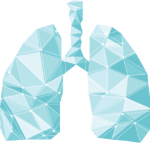The differential diagnosis included pneumonia, hypersensitivity pneumonitis, granulomatous disease, chronic eosinophilic pneumonia and other possibilities, Dr. Dellaripa said.
In this case, he turned his attention to interstitial pneumonia—either idiopathic or usual interstitial pneumonia, non-specific interstitial pneumonia or lymphocytic interstitial pneumonia associated with a systemic disease.
Example 2
Another patient, a 39-year-old man with weakness, dyspnea and elevated CK, showed a radiographic finding with a kind of “rind” of consolidation along the sub-pleural space. Known as the “atoll sign,” this is a mark of organizing pneumonia.
“If you have this [type of] patient and they are not previously immunosuppressed and they have this radiographic finding, this is consistent with organizing pneumonia and would be consistent with their underlying anti-synthetase syndrome,” he said.
Cryptogenic organizing pneumonia is characterized by organizing pneumonia and granulation in the distal airways. It usually responds to steroids, with steroids tapered slowly over six months to a year. It is seen in idiopathic inflammatory myopathy, RA, lupus and systemic scleroderma.
“Always remember that acute onset of what looks like organizing pneumonia in a generally well patient should raise the suspicion of a connective tissue disease,” Dr. Dellaripa said. “And that’s what you need to remind your pulmonary critical-care colleagues.”
Clues to a connective-tissue disease can be found by examining the mouth, skin, nailfold, joints and esophagus.
This patient was ultimately found, on autopsy, to have hyaline membrane disease.
“Unless you can stabilize this [type of] patient and bridge them to transplant, it’s going to be very hard to get a meaningful recovery,” he said.
Other Possibilities
Dr. Dellaripa drew attention to anti-melanoma differentiation-associated protein 5 (MDA5), which can induce production of Type 1 interferon. It can be associated with dermatomyositis, but is often seen in clinically amyopathic cases. The distinguishing traits include ulcerating nodular lesions and calcinosis. It’s important to consider because it can add urgency to a case, he said.
“I think there is a strong suggestion that these patients have a high level of mortality and we need to be aggressive early to try to treat these patients effectively,” he said.
The main reasons for rheumatology consults in the ICU are vasculitis, interstitial lung disease due to a confirmed or suspected case of connective tissue disease & SLE.
He added that, when inflammatory skin lesions and interstitial lung disease are involved, possibilities include inflammatory myositis, SLE, vasculitis and anti-phospholipid syndrome—“and you’re going to have to gear your investigation and consideration for therapy along those lines.”


